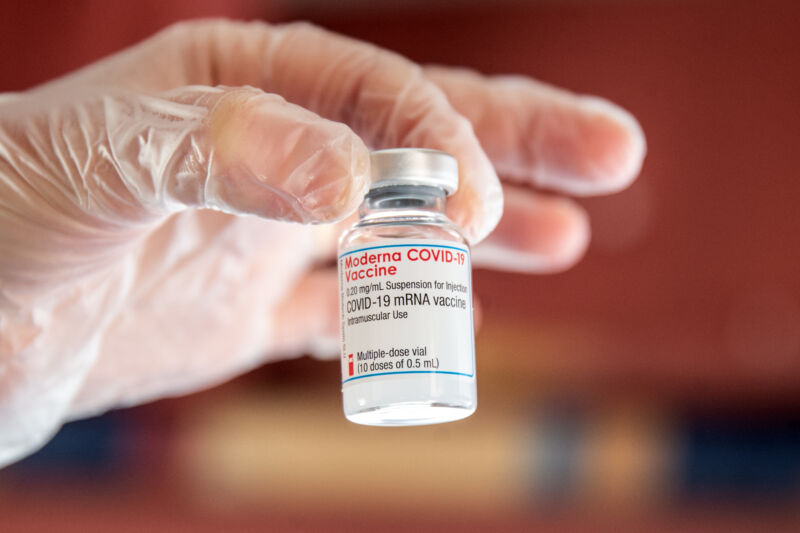A combination COVID-19 booster dose that targets the ancestral strain of SARS-CoV-2 and the initial omicron variant, BA.1, appears to outperform the current booster against both of those versions of the virus, Moderna reported Wednesday.
Specifically, Moderna says the combination booster increased neutralizing antibodies against omicron 8-fold, while the original booster only increased antibody levels around 4.4-fold.
The vaccine maker is angling to have this bivalent shot—dubbed mRNA-1273.214—be the go-to booster for seasonal shots this fall. The company will be submitting its data to the Food and Drug Administration in the coming weeks and says it hopes to have the bivalent booster available by late summer, if not early fall.
Moderna says this dose is the second bivalent design that can outcompete its current booster. In April, the company reported data that a bivalent booster targeting the ancestral strain and the beta variant (booster mRNA-1273.211) could also outperform the current booster. That data solidified the company's track to focus on bivalent boosters moving forward.
"We are thrilled to share the preliminary data analysis on mRNA-1273.214," Moderna CEO Stéphane Bancel said in a statement on Wednesday. "Looking at these data alongside the durability we saw with our first bivalent booster candidate, mRNA-1273.211, we anticipate more durable protection against variants of concern with mRNA-1273.214, making it our lead candidate for a fall 2022 booster."
Boosted uncertainty
There's still much uncertainty about a fall booster campaign—including what boosters will be offered and to whom. It's also still unclear if SARS-CoV-2 will become a seasonal virus. But, given the continued waves of variants and subvariants, along with waning immunity from current vaccines and boosters, vaccine makers, regulators, and experts have broadly accepted the idea of a fall booster campaign for this year.
The FDA will convene its panel of independent expert advisors on June 28 to plan for fall and future boosters. Specifically, advisors will discuss "whether and how the SARS-CoV-2 strain composition of COVID-19 vaccines should be modified." The panel—the Vaccines and Related Biological Products Advisory Committee (VRBPAC)—will not mull specific products but help establish guidelines for updating COVID-19 vaccines, much like the guidelines for deciding the formulas for yearly flu shots. Moderna said it would present some of its data at the meeting.
The meeting is already shaping up to be a remarkably challenging one. If vaccine makers are to have booster doses made, distributed, and ready to go in arms for the fall, they need to have the design selected and manufacturing underway as soon as possible. But the data guiding the design decisions will be extremely limited. For instance, Moderna's latest bivalent booster is based on the BA.1 omicron subvariant, which is no longer circulating in the US. In fact, two subvariants—BA.2 and BA.2.12.1—have already reached dominance since the BA.1 wave in January. And two additional subvariants—BA.4 and BA.5—appear poised to overtake the current reigning version of omicron, BA.2.12.1.
Varying variants
Preliminary data suggests the newer subvariants can evade antibody responses generated by a BA.1 infection, raising concerns that a BA.1-based vaccine design may be less effective on the current subvariants.
Moderna did not present data on how well its BA.1-targeting bivalent vaccine performs against newer omicron subvariants. But, it's not even clear that such data would be relevant for the fall, given how quickly subvariant waves have come this year. By the winter, yet-to-be-identified variants or subvariants could conceivably be circulating.
In a webcast Wednesday, Moderna President Stephen Hoge addressed this shortcoming, saying, essentially, that the levels of antibodies they see with the new omicron-based bivalent booster are high enough that even if efficacy is dinged by new subvariants, the booster will still be protective.
"We feel strongly the data we have shows that it is appropriate" to update the booster with this bivalent design, Hoge said. "In fact, we think [it's] strongly desirable to update the sequence of the vaccine with an omicron-containing variant because of the ability to achieve significantly higher titers, which we think will correlate with better durability and better protection against omicron subvariants throughout the winter."
So far, Moderna doesn't have any data to back that up. But the data it does have looks strong so far, at least at protecting against BA.1 and outcompeting the original booster.



3175x175(CURRENT).thumb.jpg.b05acc060982b36f5891ba728e6d953c.jpg)

Recommended Comments
There are no comments to display.
Join the conversation
You can post now and register later. If you have an account, sign in now to post with your account.
Note: Your post will require moderator approval before it will be visible.